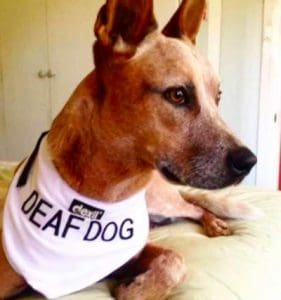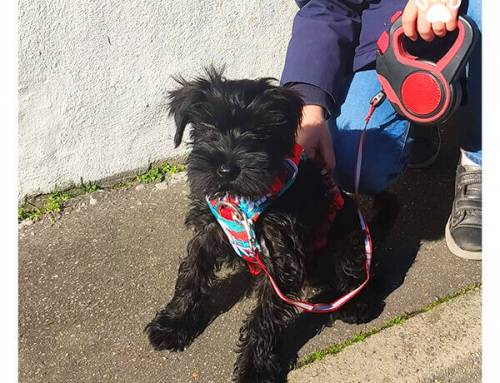Deafness in dogs can be caused by a severe ear infection, trauma, drugs, frequent exposure to loud noises, or genetically predisposed. More than 30 breeds of dogs have a known susceptibility for deafness, including Australian shepherd, Dalmatian, Jack Russell terrier, and Maltese. Being hearing impaired although takes away the ability to react and orientate oneself with sound, however, strongly enhances smell receptors. Training a deaf dog requires some adaptation. In this blogpost, Dogo team outlays some key differences.
It is important to note that even though deafness can be a challenge for dogs, it can also be an opportunity for them to develop other senses, such as smell. By relying more on their sense of smell, deaf dogs can actually become better at detecting certain scents, which can be useful in various situations. Additionally, training a deaf dog requires patience, consistency, and creativity. With the right approach, however, it is possible to train a deaf dog to be well-behaved, obedient, and happy.
Is my dog deaf?
The first thing people notice is a failure to respond to a sound. Other signs include unusual behavior such as excessive barking, unusual voice, hyperactivity, confusion when given vocal commands, and lack of ear movement. An animal that has gradually become deaf, as in old age, may become unresponsive to the surroundings and refuse to answer the owner’s call.
You can download the Dogo whistle app and while your dog is asleep or facing away from you, tap the whistle with different frequencies. Observe the ear movements or reactions of your dog. You can also jingle the keys, clap your hands when your dog is asleep to elicit a reaction.
Non-verbal cues
Dogs are great body language readers, therefore your hearing-impaired puppy will have no problems learning hand signal meaning. First, make sure your dog knows a command well with a verbal cue or luring in case of a deaf dog. Say the cue at the same time show a hand signal that you assign to the command. For example for lay down command show your palm facing down, if your dog is off the leash wave your hands in the air for a recall. Be creative, make sure every family member uses the same hand signals.
It is important to remember that hand signals should be consistent and clear. Avoid using overly complex or confusing signals, and make sure that every family member uses the same signals to avoid confusion. Additionally, it is important to practice hand signals regularly and reinforce them with positive reinforcement, such as treats or praise. With enough practice and consistency, your deaf dog will learn to associate hand signals with specific commands and behaviors, and will be able to follow them reliably.
To praise your dog and to say “good dog”, show thumbs up or use in the Dogo app clicker adopted to deaf dogs. Every time you click, the flashlight goes on. Of course, first, you have to “charge” the cue as any other. For a few days, practice this very enjoyable exercise: have your dog sit in front of you, press the clicker, give a treat. Repeat the exercise with 20 treats. Yummy!
Attract attention
At home, in a fenced and safe environment, you can rely on vibrating collars to get your dog’s attention. Again make the positive association. First, have your dog on a leash with the collar, press on vibrate, if your dog looks you in the eyes, give immediately a treat. If your dog ignores the vibration, hold the treat near her nose and move it towards your forehead, so your dog follows the treat and looks you in the eyes. It is very important that you train your dog to look you in the eyes and wait for further cues. If you don’t use the collar, you can pull twice gently on the leash for the “watch me” command or stomp with your foot on the floor, so your dog reacts to vibrations.
When using vibrating collars, it is important to use them responsibly and not rely on them too heavily. Overuse of vibrating collars can be harmful to your dog’s well-being and can cause stress or anxiety. Additionally, it is important to choose a collar that fits well and is comfortable for your dog to wear. If your dog is uncomfortable or unhappy with the collar, they may be less likely to respond to it. Finally, it is important to practice using vibrating collars and other attention-getting techniques in a safe and controlled environment before using them in more challenging situations, such as when walking in public or in unfamiliar surroundings.
Being startled
Hearing-impaired dogs are easily startled and your responsibility is to work on a few things: condition your dog that touch is always followed by a delicious piece of food and teach your dog bite inhibition that if startled she chooses to mouth your hand, leg instead of biting it.
Dogs get easily startled when suddenly woken up. They cannot hear you approaching, so make sure, you approach calmly and slowly. If your dog is asleep, you can tug on a blanket gently, once your dog is awake, give him a treat and gently touch on the shoulder. Alternatively, you can hold a strong-smelling treat a few centimeters away from his nose and let him wake up from the delicious aroma. In the Dogo app check out the training “grabitis” in the useful section, how to prevent your dog from being hand-shy.
Bite Inhibition
When dogs are hurt or startled, their natural response is to lunge or bite. The most efficient way puppies learn bite inhibition is through play. If your puppy didn’t have a lot of interaction with other pets, it is your responsibility to teach it. Bite inhibition doesn’t mean that your dog is not going to growl or lunge. It means your dog will not break the skin when threatening another dog or person to leave them alone. If your dog nips you, stand up, turn away, and pretend to care for your “wound”. After a minute of your dog being quiet resume play. Once your dog learns to be gentle, teach the command “leave it”, e.g. showing a palm facing your dog, as if you would stay “stop it”. Once your dog retreats and waits, give a treat as a reward.
Make sure to have your dog on a leash in an unknown surrounding, have them microchipped, and wear a name/phone tab on the collar, in case your dog runs away. Training a deaf dog can be challenging but if you dedicate enough time and attention, it will bring amazing results. Good luck!
Create a Personalized Training Plan for your Dog






